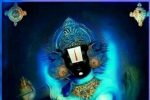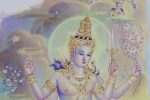NAME 58
Lohitākṣaḥ लोहिताक्षः
He is red eyed. Red is the colour of compassion. Lalitā Sahasranāma describes Lalitāmbikā red in complexion. His eyes can also be compared to the rising sun, which is red in colour. Without sun, the universe cannot function. In the same way, without the grace of His eyes, the universe cannot sustain. His red eyes are the indicators of His compassion for His creation. The Brahman not only creates, but also nourishes His creations. He is the embodiment of compassion.
One with eyes red like the beautiful lotus flower.
Lohitaaksha: Lohita means Red and Aksha means eye and so Lohitakshah means somebody whose eyes are Red as in Lotus flower. As Sri Adi Shankara puts it ‘Lohite Akshinee yasya iti Lohitaakshah – One whose eyes are Red’.
Taitriya Aranyam says ‘Samaa Vrishabho Lohitaakshah – He is Supreme and has Red eyes.’
Sri Parasara Bhattar attributes two meanings, one where his eyes are red as a result of extreme joy and another as a result of His anger towards evil-doers.
Earlier in Shloka 5 we have already seen the name ‘Pushkaraakshah’ with similar meaning.
५८. ॐ लोहिताक्षाय नमः |
58. OM Lohitākṣāya Namaḥ
Lohitaakshah -Red-eyed. Very often we find descriptions in the Puranas, where the Lord is explained as having eyes like the red-lotus (Hibiscus). Generally the ruddy eyes represent anger and the incarnations are taken for the purpose of destroying the evil and so His anger is towards the evil-minded materialists who live ignoring the higher values of life.
Lohite Akshini Yasya Sah Lohitakshah.
Lohite akṣiṇī yasya saḥ – One whose eyes are tinged red. Asā vr̥ṣabho lohitākṣaḥ – The Supreme Lord who is Lohitākṣaḥ (Taittirīya Āraṇyaka 4.42)
विरिञ्चो भगवान्दृष्ट्वा सह शर्वेण तां तनुम् ।
स्वच्छां मरकतश्यामां कञ्जगर्भारुणेक्षणाम् ॥ ३ ॥
श्रीमद्भागवत – अष्टम स्कंद, षष्टोऽध्याय
Śrīmadbhāgavata – Canto 8, Chapter 6, verse 3
Viriñco bhagavāndr̥ṣṭvā saha śarveṇa tāṃ tanum,
Svacchāṃ marakataśyāmāṃ kañjagarbhāruṇekṣaṇām. (3)
Lord Brahmā, along with Lord Śiva, saw the crystal clear personal beauty of the Supreme Personality of Godhead, whose blackish body resembles a marakata gem, whose eyes are reddish like the depths of a lotus.
INTERPRETATION GUIDED BY SANT VANI (WORDS OF SAINTS)
Lohitākṣaḥ
The red-eyed.
He is Lohitākṣa because His eyes are lohita, reddish in colour.
The rose-tinged or red-eyed one. He whose eyes are as beautiful as the red-lotus petals (sometimes reference is also made to the red hibiscus).
This is a compound word made up of Lohitā meaning red and Akṣa meaning eye.
Why the red-eye? Parāsara Battar states that “his eyes are red like the beautiful lotus, which reflects the great joy and bliss that ‘he is’ ” (Bliss that he is personified as and the bliss that one attains by connecting to him).
One of the translations of Śaṅkara’s commentary interprets the red eyes as an expression of anger against the asuras and adharmis or a reference to the avatāras (particularly the avesha-avatāras, like Nārasimha or the raudra-avatāras like Paraśurāma ).
However, it is the beautiful lotus-eyed one, rose-tinged at times and red at other times depending on the light that catches those brilliant eyes is what seems most relevant. Then again, the Sashasranama beads are not words simply strung together but carefully curated, selected and strung together to make meaning individually, jointly and also collectively.
Connecting this name to the previous name in this string: Kṛṣṇa who was variously called Puṇḍarīkākṣa or Vṛṣabhākṣa we can conclude that this is a name of the Supreme being who is the very manifestation of ākarṣaṇa (attractive-magnetism) who attracts and draws those who reach out to him and holds them in his sway. The rose-tinged eyes are the eyes of supreme compassion and love for his devotees.
“He” as the red-tinged in-dweller in the Solar orb of the morning Sun signals the dawn of a fresh day giving us an opportunity to start afresh again – no matter what our present state of being be…
The Taittirīya-āraṇyaka says, ‘sa mā vṛṣabho lohitaākṣaḥ sūryo vipascin-manasā punātu–May the Lord as the red-eyed Sun protect me’ (4.42).
The Lord is manifest as our solar system also and hence, the rising sun and the rising moon, which are red in color. The idea is, be it night or day, the eyes of the Lord are always seen in the form of either the sun or the moon. The sun and the moon are nothing but the manifestation of the Lord. We meditate on the Lord who has the sun and the moon as His eyes. This is for the purpose of upāsanā.
Beautiful Dhyana of Mahapurush vidya on Lord Pundarikaksha – the Lotus eyed one.



